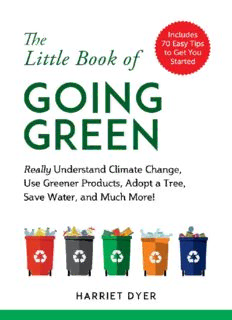
The Little Book of Going Green: Really Understand Climate Change, Use Greener Products, Adopt a Tree, Save Water, and Much More! PDF
Preview The Little Book of Going Green: Really Understand Climate Change, Use Greener Products, Adopt a Tree, Save Water, and Much More!
Contents INTRODUCTION WHAT IS CONTRIBUTING TO CLIMATE CHANGE? Plastics Fossil Fuels Industrial Agriculture Deforestation Human Population HOW CAN WE REDUCE OUR CARBON FOOTPRINT? Businesses Individuals RESOURCES WE HAVE FORGOTTEN HOW TO BE GOOD GUESTS, HOW TO WALK LIGHTLY ON THE EARTH AS ITS OTHER CREATURES DO. BARBARA WARD INTRODUCTION The human impact on global climate change has only relatively recently been realized. Arguably, the father of climate-change science is Svante Arrhenius from Sweden, whose work, published in 1896, opened the channel of thought on the topic of the negative impact fossil fuels might have on the planet. However, it wasn’t until greater funding became available in the 1950s that researchers could get firm data in place to start to prove their ideas. Then, in 1988, the United Nations founded the Intergovernmental Panel on Climate Change to assess the relevant studies. Research continues, but it is now clear that human progress has adversely affected our environment. Up until the middle of the eighteenth century, though coal was also used, the main source of fuel was wood—a renewable biomass energy source. Then the Industrial Revolution arrived and caused a shift in the way humans lived. Coal overtook wood as the primary source of energy and the population of the world exploded, meaning there was a bigger demand for this energy source. From that point, there was no going back; we continued advancing and soon discovered oil and natural gas could also serve as energy sources, which further contributed to climate change. Unaware of the consequences it would have, we pumped toxic chemicals and gases into the atmosphere, creating “the greenhouse effect” (where greenhouse gases act like a blanket trapping heat inside the Earth’s atmosphere) and causing an increase in global temperatures we now call “global warming.” Although many of us are aware of the damage caused to the planet by human progress, few of us are actively trying to reduce how much we contribute to it. Consumerism has become a central focus in society: we have come to expect too many things and take too much for granted, whether it’s the expectation of foreign travel, owning the newest technological innovation, fast food consumption, commuting to work, or simply flicking the heating on at the first sign of cold. We bury our heads in the sand about the impact we have on the environment and spend little time addressing how we could change our lives for the good of the planet. We can’t just hope that other people will take charge of making improvements—every one of us needs to be involved to have an impact. This book is an introduction to the main ways we are damaging the environment and how we can each contribute to being more earth-friendly. WHAT IS CONTRIBUTING TO CLIMATE CHANGE?
Description: